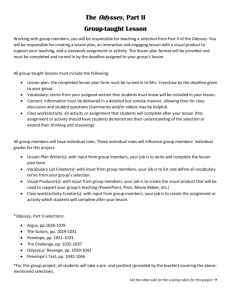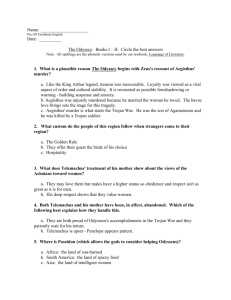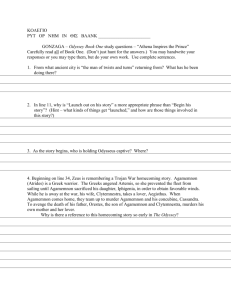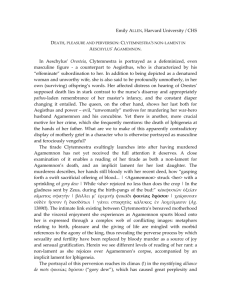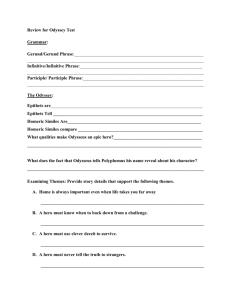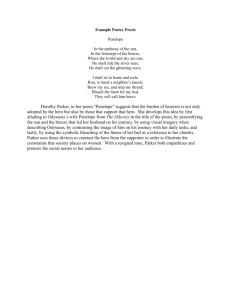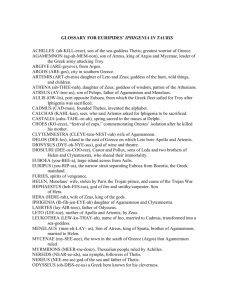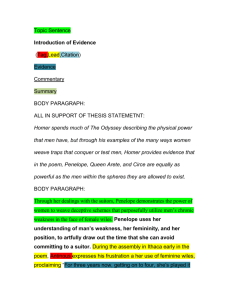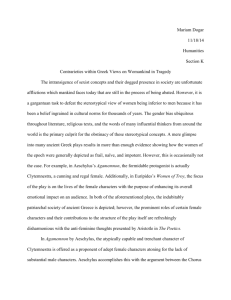Δολόμητις Πηνελόπεια: Clytemnestra and Penelope in the
advertisement
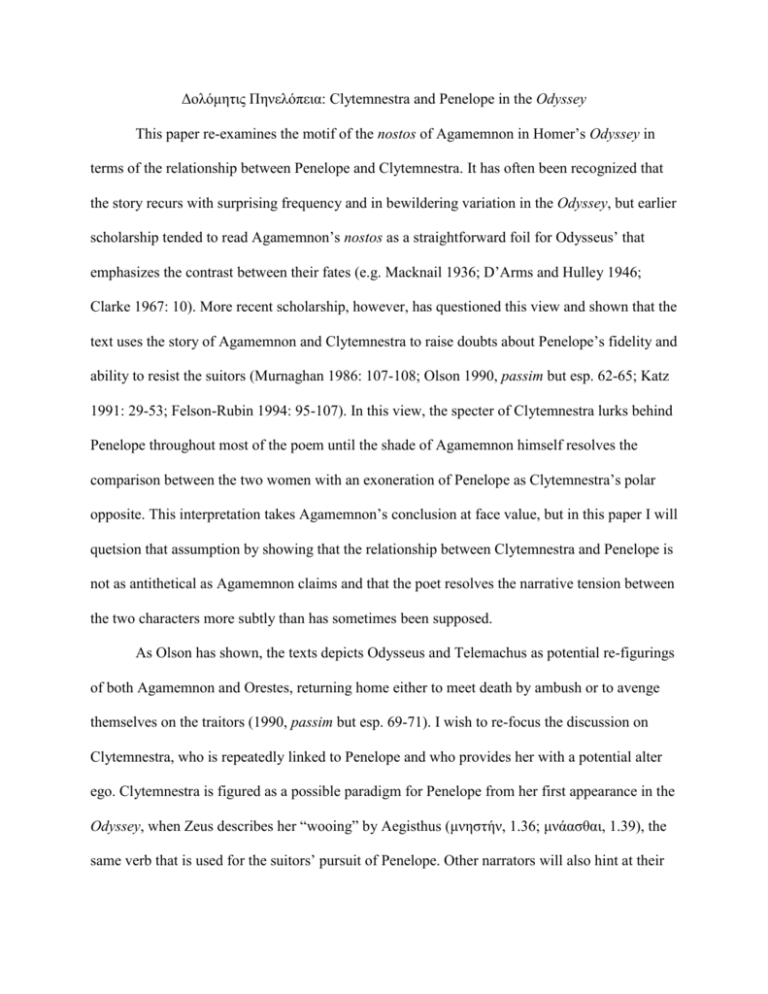
Δολόμητις Πηνελόπεια: Clytemnestra and Penelope in the Odyssey This paper re-examines the motif of the nostos of Agamemnon in Homer’s Odyssey in terms of the relationship between Penelope and Clytemnestra. It has often been recognized that the story recurs with surprising frequency and in bewildering variation in the Odyssey, but earlier scholarship tended to read Agamemnon’s nostos as a straightforward foil for Odysseus’ that emphasizes the contrast between their fates (e.g. Macknail 1936; D’Arms and Hulley 1946; Clarke 1967: 10). More recent scholarship, however, has questioned this view and shown that the text uses the story of Agamemnon and Clytemnestra to raise doubts about Penelope’s fidelity and ability to resist the suitors (Murnaghan 1986: 107-108; Olson 1990, passim but esp. 62-65; Katz 1991: 29-53; Felson-Rubin 1994: 95-107). In this view, the specter of Clytemnestra lurks behind Penelope throughout most of the poem until the shade of Agamemnon himself resolves the comparison between the two women with an exoneration of Penelope as Clytemnestra’s polar opposite. This interpretation takes Agamemnon’s conclusion at face value, but in this paper I will quetsion that assumption by showing that the relationship between Clytemnestra and Penelope is not as antithetical as Agamemnon claims and that the poet resolves the narrative tension between the two characters more subtly than has sometimes been supposed. As Olson has shown, the texts depicts Odysseus and Telemachus as potential re-figurings of both Agamemnon and Orestes, returning home either to meet death by ambush or to avenge themselves on the traitors (1990, passim but esp. 69-71). I wish to re-focus the discussion on Clytemnestra, who is repeatedly linked to Penelope and who provides her with a potential alter ego. Clytemnestra is figured as a possible paradigm for Penelope from her first appearance in the Odyssey, when Zeus describes her “wooing” by Aegisthus (μνηστήν, 1.36; μνάασθαι, 1.39), the same verb that is used for the suitors’ pursuit of Penelope. Other narrators will also hint at their potential similarity: Nestor tells Telemachus that Clytemnestra initially refused Aegisthus’ charms because she had a virtuous mind (φρεσὶ γὰρ κέχρητ᾽ ἀγαθῇσι, 3.266) but was eventually overcome by the will of the gods (3.269). Nestor and Athena both imply that Penelope may suffer the same fate when they caution Telemachus not to stay too long away from Ithaca (3.313316; 15.22-23). The stories of Agamemnon and Menelaus hint at a connection between Clytemenstra and Penelope through Clytemnestra’s use of deceit (δόλος: 4.92; 11.422) and guile (μῆτις: 11.422; 11.429; 24.199). Penelope herself describes the trick of the weaving as both a δόλος (19.137) and a μῆτις (19.158) and Agamemnon claims that she knows μήδεα (11.445). Thus, Clytemnestra and Penelope are both characterized by their potential for infidelity and their capacity for trickery. Agamemnon’s closing speech—the last word on Penelope, Clytemnestra, and women in general in the Odyssey—appears to settle the comparison in terms of a straightforward opposition: Penelope was virtuous and has earned a “gracious song” (ἀοιδὴν…χαρίεσσαν, 24.197-198) from the immortals whereas Clytemnestra will receive a “hateful song” (στυγερὴ δέ τ᾽ ἀοιδὴ, 24.200) for killing her husband. Yet this simple formulation is undermined by the very narrative that inspired it: the story of the suitors’ death, narrated by one of their shades. According to him, Penelope plotted the suitors’ deaths (24.127) and conspired against them with Odysseus (24.167-168)—much as Clytemnestra and Aegisthus plotted against Agamemnon (cf. Olson 1990: 70). Furthermore, other verbal clues link Agamemnon with the suitors and Clytemnestra with Penelope. This paper will conclude by tracing these similarities and will argue that the poet—after teasing his narratees throughout the poem with stories that hint that Penelope may become another Clytemnestra—resolves the comparison, not by denying the many parallels he has constructed between the two women, but by reaffirming them in the words of the suitor’s ghost. It is the suitors who play Agamemnon to Penelope’s Clytemnestra, and their spokesman unknowingly provides yet another retelling of Agamemnon’s nostos and death at the hands of Clytemnestra and Aegisthus. Bibliography Clarke, H. W. 1967. The Art of the Odyssey. Englewood Cliffs. D’Arms, E. F. and K. K. Hulley. 1946. “The Oresteia-Story in the Odyssey.” TAPA 77: 207-213. Felson-Rubin, N. 1994. Regarding Penelope. From Character to Poetics. Princeton. Katz, M. A. 1991. Penelope’s Renown: Meaning and Indeterminacy in the Odyssey. Princeton. Macknail, J. W. 1936. “The Epilogue of the Odyssey.” In Greek Poetry and Life: Essays Presented to G. Murray: 1-16. Oxford. Murnaghan, S. 1986. “Penelope’s Agnoia: Knowledge, Power, and Gender in the Odyssey.” In Rescuing Creusa: New Methodological Approaches to Women in Antiquity, ed. M. Skinner: 103-116. Texas Tech University Press. Olson, S. D. “The Stories of Agamemnon in Homer’s Odyssey.” TAPA 120: 57-71.
